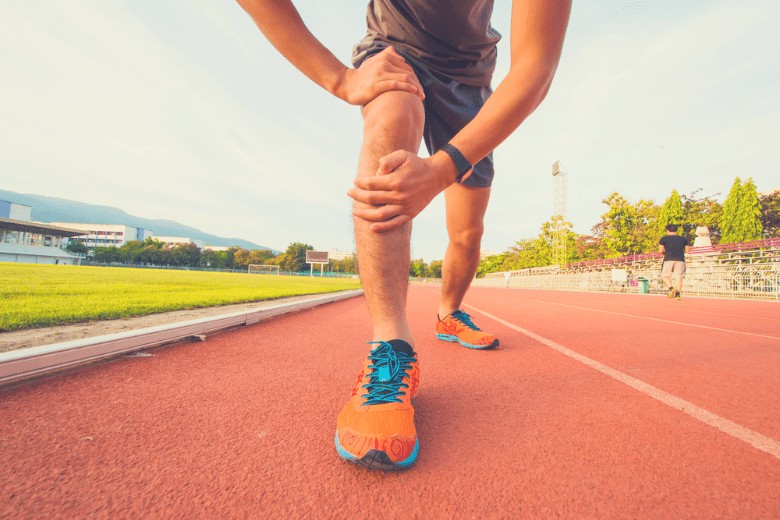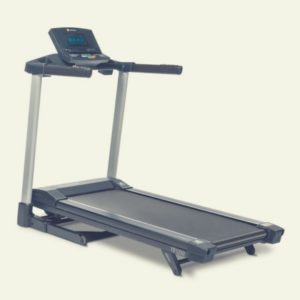Bottom Line:
- Joint lubrication is important for healthy joints
- Poor joint lubrication in your joints can lead to joint pain
- Proper exercise can actually be good for joint lubrication
One morning, I was sitting on the floor of my grandparents’ kitchen, and I legitimately watched my grandmother spray WD-40 on her knees and hips.
Worried, I chuckled nervously and asked the woman I loved most in the world, only half joking, if she’d finally lost her mind.
She insisted, however, that she hadn’t and that she was just “oiling up these old bones.”
At the time, I was still about 25 years away from hearing my doctor tell me I needed better joint lubrication, but the moment the words were out of his mouth, that’s the image that popped into my head.
What Is Joint Lubrication, and Why Does It Matter?
In case you were wondering, lubricating your joints is not as simple as spraying a little WD-40 on your knees, elbows and ankles, but believe it or not, the principles are very similar.
Your body produces something called synovial fluid, which is basically this thick fluid that “oils up” your joints and keeps them lubricated and moving smoothly.
The synovial fluid acts as a sort of liquid padding for your joints and allows your bones to glide smoothly across one another when you move instead of scraping against each other, dry bone against dry bone.
If, for some reason, you aren’t producing enough synovial fluid, your joints won’t be properly lubricated, and that can cause some serious problems down the line.
In other words, synovial fluid is to your joints what WD-40 is to a squeaky door hinge.
Without proper lubricant, both your joints and the hinge get “squeaky” and stop working properly.
What Causes You to Not Have Enough Lubrication in Your Joints?
Age
One of the most common causes of a decreased amount of synovial fluid in your joints is age.
That’s why, as we get older, our bones and joints seem to ache more than they ever did when we were young.
There are some things you can do to help combat this problem, though, as long as it’s caused strictly by aging.
We’ll get to that here in just a bit.
Obesity
Another common cause of joint pain is obesity. Part of this has to do with the fact that carrying around excess fat simply puts a lot more strain on your joints.
Take an empty cardboard box, and place it on it’s side. Then start stacking books on top of it.
Eventually, the box is going to collapse due simply to the weight being placed on it.
That’s a crude but semi-accurate representation of what happens to your joints when you put more and more excess weight on them.
However, several studies have also shown that obesity can cause trouble with synovial membranes and the production of synovial fluid as well.
That makes obesity a double whammy for joints.
Not only are obese people adding more weight to their joints, but they’re also potentially messing up their synovial membranes and impacting the amount of synovial fluid their body produces, which makes that extra weight hurt even more.
Some Viral Infections in Children
There’s also a condition known as Toxic Synovitis (or Transient Synovitis) that sometimes occurs in children.
It causes the synovial membrane to become inflamed, which in turn, upsets the production of synovial fluid.
The exact cause of the condition isn’t conclusively known, but many doctors believe it occurs after a child has been exposed to a viral infection of some kind.
The bad news is that beyond anti-inflammatory drugs, there isn’t much you can do for it, but the good news is that it usually goes away on its own in a couple of weeks anyway.

What Happens When Your Joints Aren’t Properly Lubricated?
If you aren’t getting enough joint lubrication, things can go downhill in your joints fairly quickly.
The most obvious symptom is going to be pain.
Your joints are going to start hurting and aching, and it’s not going to be an easy pain to fix.
Additionally, the longer you go without enough joint lubrication, the longer your bones are rubbing and grinding against one another.
Not only do these bones rubbing across each other cause you more pain, they can also cause a lot of damage to the bones that are scraping against each other and other surrounding bones, ligaments, muscles and tissues.
Tissue can become inflamed (synovitis); bones can start eroding; joint capsules can swell, and ligaments can be damaged, sometimes irreparably.
If left untreated for too long, you can be left with chronic pain issues and can even lose the range of movement in the bones connected by the affected joints.
Of course, once you can no longer move like you should be able to move, you can’t do a lot of the things you used to do.
Your muscles will start to get weaker and erode; you’ll likely start to put on weight.
It’s a big, ugly downward spiral of pain and damage, so correcting poor lubrication sooner rather than later is strongly advised.
How Can You Keep Your Joints Lubricated?
It’s true that all of this sounds pretty terrifying, and it is, but there are things you can do to help increase synovial fluid production to keep your joint lubrication at peak levels.
Exercise Regularly
Believe it or not, regular exercise is actually really good for lubricating your joints.
I know how sore exercise can sometimes make you, and if you take part in a massive, high-intensity workout or cross-country run, you may even feel like your body is worse off than it was before you exercised, but those are just normal everyday aches and pains from hard work and exertion.
Exercise is actually really good for synovial fluid production and joint lubrication, not to mention it can help cut down on swollen joints.
This is because exercise boosts the circulation of synovial fluid in your joints.
As you exercise, it’s almost like the synovial fluid heats up, which makes it thinner and more mobile, which in turn, allows it to coat the entire joint area more easily.
Additionally, exercise moves around water molecules that might be trapped in the joints and causing you pain.
Your bones slide over one another more easily, and your range of movement is improved. It also can help you burn calories and lose weight, which takes a lot of pressure off of your joints.
Drink More Water
Drinking water also helps stimulate the production of synovial fluid.
It increases the volume of the existing synovial fluid, as well, which allows it to provide even more cushion for the joints than it’s already providing.
Water also helps keep you hydrated and improves circulation and blood flow.
Drinking plenty of water can help you feel fuller, causing you to eat less, and again, any lessening of weight on your joints is always a good thing.
Adjust Your Diet
There are all kinds of foods you can eat to help improve your joint lubrication and the production of synovial fluid in your body.
Just like other parts of your body, your synovial fluid can accrue toxins and/or bacteria, and if that happens, things can take a turn for the worse.
Help keep your synovial fluid free of these types of things by consuming lots of foods that are high in antioxidants.
Antioxidants have also been linked to a greater production of synovial fluid. Green, leafy vegetables and yogurt are very high in antioxidants.
Additionally, any foods that are high in Omega-3 fatty acids can also provide big benefits when it comes to lubricating your joints.
These types of foods include salmon, trout, mackerel, avocados, chia seeds, walnuts and olive oil.
The fatty acids in these foods make them “oily,” which is actually really great for assisting with the lubrication of the joints.
Finally, if you’re eating an overall unhealthy diet, you should adjust your diet in other ways. Cut back on your sweets and the sugary sodas.
Don’t cut out carbs completely; that can do more harm than good, but eat healthy carbs as opposed to things like candy bars and cakes.
Find the problem areas in your diet, and work on ridding yourself of those.
Lose Weight
Exercising more, drinking more water and adjusting your diet should all help you lose weight, but if you’re carrying around extra pounds and have started to notice joint pain, then losing weight is essential.
For that reason, I wanted to give it its own section. The more overweight you are, the more problems you’re going to have with your joints.
That’s just a fact, so whether it’s through dieting or a combination of diet, exercise and staying hydrated, do what you need to do to shed some pounds.
Your joints will thank you.
Take Supplements
If you’re like me and just can’t bring yourself to eat fish, you might consider taking supplements instead.
Some supplements that have been credited with helping to lubricate your joints and decrease joint pain overall are fish oil, boswellia, turmeric, glucosamine, S-adenosyl-L-methionine, methylsulfonylmethane and chondroitin.
These work in different ways, and the science behind some of them is contradictory depending on who you ask, but people I know have had varying levels of success either improving synovial fluid production and joint lubrication or in simply relieving joint pain.
Joint Injections
The best way to combat poor lubrication in the joints is to start working on it early, before it ever becomes a problem.
If it has already become a problem, and diet, exercise, supplements and extra hydration don’t seem to be helping, there are procedures that can help alleviate some of the pain of poorly lubricated joints.
One of the procedures that’s becoming more popular is simply called a “joint lubrication.”
During these procedures, a concentrated dose of hyaluronic acid, which is the naturally occurring acid found within synovial fluid, is injected directly into the joint.
These kinds of procedures are usually performed by orthopedic doctors or surgeons, and as with all medical procedures, they should be well-researched and performed only after you and your doctor have determined there’s no better course of action.

Summing It Up
Joint lubrication is important for good joint health, and having proper lubrication can help cut down on a lot of joint pain and discomfort.
The body’s production of synovial fluid, which is full of a substance called hyaluronic acid, is what lubricates healthy joints.
It fills up the cavities around joints and acts as a type of padding that keeps your bones from scraping against one another when you move.
If your joints aren’t properly lubricated, all kinds of bad things can happen.
In addition to pain, you can also cause long-lasting or even permanent damage to your joints, bones, muscles, tissues and ligaments, so it’s incredibly important to keep them well-lubricated.
Exercising, drinking enough water, eating a diet high in Omega-3 fatty acids and antioxidants and taking certain supplements can help ensure that the lubrication of your joints stays as good as it can as you age.
Keeping off excess pounds is also a big help.
If you’re already experiencing some of the negative side effects of poor lubrication, talk to your doctor to see what your best course of action is.
If you don’t combat it soon, it’ll only get worse as you age, so do your best to take care of your joints and all the rest of your body for as long as you possibly can.



